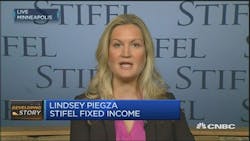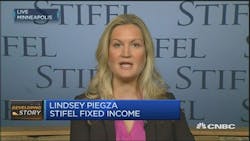Is a sour economic note being sounded for trucking?
Suddenly, the freight market – indeed, the U.S. economy as a whole – finds itself on far shakier ground than many predicted a little over a month ago, though some believe the slowing pace of cargo transport demand is only a temporary situation.
First, U.S. gross domestic product (GDP) growth hit the brakes rather significantly in the third quarter, falling to 1.5% compared to the 3.9% surge in the second quarter this year.
The Bureau of Economic Analysis (BEA) pinned much of the blame for that “deceleration” on a “downturn” in private inventory investment and reductions in export volume.Lindsey Piegza (at left), chief economist for Stifel Fixed Income, noted that coupled with an average GDP growth rate of 2.3% in the first half of 2015, the U.S. economy is tracking 2% across the first nine months of the year, slightly below the 2.2% trend rate since the end of the Great Recession.
That contains both good and bad news for the economy, from her perspective.
“It’s a disappointing topline reading on domestic activity; however, the composition [of the economic data] suggests a slightly more positive story,” Piegza said in a recent research note.
“Consumers were still out spending July to September, and businesses were still investing, albeit at a markedly slower pace than in the second quarter. Even exports were kept out of negative territory despite a continued rise in the U.S. dollar.”Yet the big question remains: will the U.S. economy continue to bleed momentum as the finish line for the final quarter of the year approaches?
“After all, without a marked improvement in hiring and positive income growth, will consumers be able to maintain even a modest pace of spending?” she asked. “Furthermore, with business spending slowing across the past nine months, will the downward trend be arrested or continue to erode topline growth?”
Here are few more troubling data points that Piegza highlighted to explain her economic thinking:
- Durable goods orders fell 1.2% in September, slightly less of a decline than expected. Yet orders are down 3% over the past 12 months, the eleventh consecutive month of decline.
- Retail sales only inched up 0.1% and are only up 2.5% versus last year.
- New home sales plunged 11.5% in September, the largest monthly decline since July 2013, pulling the annual pace down from 529,000 to 468,000; the weakest since November 2014.
- Industrial production fell 0.2% in September and capacity utilization declined, according to data released by the Federal Reserve.
“Global weakness, a large inventory overhang, economic uncertainty – take your pick,” Pegza noted. “The current environment leaves businesses hesitant to invest in everything from equipment to structures to additional employees. This slew of disappointing figures suggests the underlying momentum of the U.S. economy is slowing markedly.”
Things aren’t much better on a global basis, which is why come companies – such as engine maker Cummins Inc. – are battening down the hatches.Cummins said in its third quarter earnings report that it expects to reduce its professional workforce by up to 2,000 people by the end of this year – actions are expected to deliver annualized savings in the range of $160 million to $200 million, though Cummins will record a pre-tax charge of between $70 million and $90 million against its fourth quarter earnings for reducing headcount.
“We are taking difficult but necessary actions to lower costs in the face of weak demand in many of our markets,” noted Tom Linebarger (seen above), Cummins’ chairman and CEO, in a statement.
“Global off highway and power generation markets have been weak for some time and are worsening. Industry orders in key end markets in Brazil and China are at multi-year lows and showing no signs of improvement in the near-term. Given the uncertainty in the global economy, we expect challenging conditions to persist for some time.”
In the midst of all of this, trucking companies are dealing with a “multiple whammy” of sorts as driver pay raises implemented by motor carriers collide with sluggish freight demand – and thus flat rates – along with falling fuel surcharge revenues due to ongoing decline in diesel prices.
In its third quarter earnings report, TL carrier Werner Enterprises noted that it continues to “move forward” to recoup the cost increases associated with more expensive equipment, a shrinking supply of qualified drivers and an increasingly challenging regulatory environment.“Diesel fuel prices were $1.25 per gallon lower in third quarter of 2015 than in third quarter of 2014 and were 26 cents per gallon lower than in second quarter of 201,” the carrier said.
“For the first 20 days of October 2015, the average diesel fuel price per gallon was $1.00 lower than the average diesel fuel price per gallon in the same period of 2014 and 79 cents lower than in fourth quarter 2014, it noted.”
That led to a whopping one-quarter reduction in fuel surcharge revenues by $36 million in Werner’s TL segment and an estimated $7 million in its VAS [‘Value Added Service’ or dedicated division] segment. “This had the effect of reducing total consolidated revenues by an estimated 8 percentage points in third quarter of 2015 compared to third quarter of 2014,” the company noted.
Yet Werner continues to invest big bucks into driver retention efforts, such as increasing capital expedites by over $100 million to $251 million during the first nine months of this year versus the same period in 2014 to buy new trucks; lowering the average age of its units to 1.9 years by the end of September, which compares to an average age of 2.3 years by the same time point last year. “We estimate net capital expenditures for the full year of 2015 to be in the range of $300 to $325 million,” the carrier added.
Yet Werner admitted that the driver recruiting market remains “very challenging” and will stay that way for a while, despite all of its investments.
“Several difficult market factors persist including a declining number of, and increased competition for, drivJohn Larkin (at right), managing director of the transportation & logistics research group at Stifel, noted that that growing shortage of drivers – which he believes will lead to the “mother of all capacity shortages” very soon – has actually motivated shippers to take preparatory action, moving more of their freight into the contract market, to dedicated or private fleets, and converting some long-haul lanes from truck to intermodal; with some medium sized shippers outsourcing some or all of logistics planning and traffic management functions to third part logistics (3PL) firms.
“The net effect of this cumulative effort has been to utilize their existing capacity more efficiently,” he explained in a recent research note. “The combination of more efficient capacity utilization – which effectively creates more capacity – and an increasingly sluggish freight market suggests that 2015, like each of the previous five years, will be remembered as the year prior to the start of the great capacity crisis.”
But is it all really turning to sour grapes for trucking? Not necessarily so, cautioned Jonathan Starks, director of transportation analysis for research firm FTR.
“Things are certainly weaker right now than they were a few months ago; there’s no doub“But freight demand is holding up fairly well considering the current headwinds,” Starks (at left) stressed.
“Durable goods orders were weak, yes, but not terrible. We’re still struggling to get consumers back to normal spending patterns but a 0.1% in retail spending means we’re holding steady," he pointed out. "Construction activity is holding up well and though employment has slowed, it’s still in positive territory.”
Thus, though things may seem far more sluggish of late, they remain sluggish and don’t indicate to Starks at least that the economy is crashing.
We’ll take another look at the freight picture as we get deeper into the fourth quarter.






